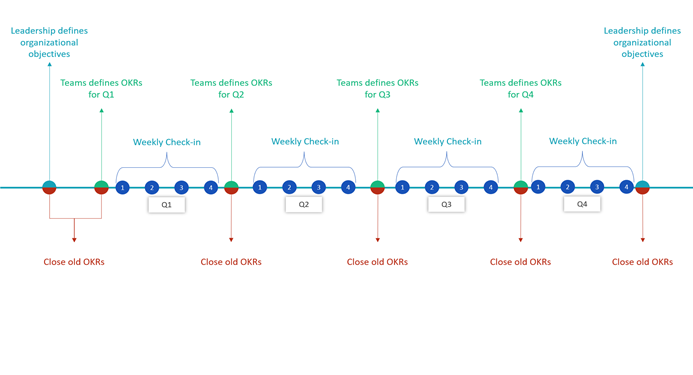During the inventory of user experiences, we were asked whether we could do ‘something’ with OKRs.
To answer this, we dived into the world of OKRs. What does it add and how can we capture this within CareerTracker.
OKR (Objectives and Key Results) is a goal setting system and it is a simple approach to create alignment and engagement around measurable and ambitious goals.
The major difference from traditional planning methods is that OKRs are determined, monitored and re-evaluated on a regular basis – usually quarterly.
Objectives: meaningful, concrete, action-oriented, inspiring
Key Results: specific and time-bound, aggressive but realistic, measurable and verifiable
The big difference with traditional planning methods?
OKRs are often set, tracked, and re-evaluated – usually quarterly. OKR is a simple, fast cadence process that engages the perspective and creativity of each team.
OKR exists to create alignment and set the cadence for the organization. The goal is to make sure everyone is moving in the same direction, with clear priorities, at a constant pace.
The original concept of OKR came from Intel and spread to other companies in Silicon Valley. Google adopted OKR in 1999, during its first year. It supported Google’s growth from 40 employees to over 140,000 today.
The foundation of OKRs
John Doerr is one of the most successful venture capitalists of all time. He started his career at Intel and then went on to invest in companies such as Google and Amazon. Doerr, who introduced Google to OKR, has a formula for setting goals:
I will ____________________ as measured by _______________________
Doerr’s Goal Formula

OKR is easiest to explain using Doerr’s formula: OKR has two components, the Objective (Objective) and the Key Results (Key Results).
Objectives are statements that inspire and give direction. Objectives should be short, inspiring and engaging. An objective should motivate and challenge the team.
Key Results are a set of measurable metrics that measure your progress toward the goal. For each objective, you should have a set of 2 to 5 key outcomes. More than that and no one will remember them.
The rhythm
Strategy and tactics have different natural tempos, as the latter tends to change much faster.
To solve this, OKR uses different rhythms:
- A strategic rhythm with long-term, high-level OKRs for the company (usually annual)
- A tactical rhythm with shorter term OKRs for the teams (usually quarterly)
- An operational rhythm for tracking results and initiatives (usually weekly)
Operational heartbeat
At CareerTracker, work according to the rhythm below.
It keeps us excited and with the right focus.

2 Responses